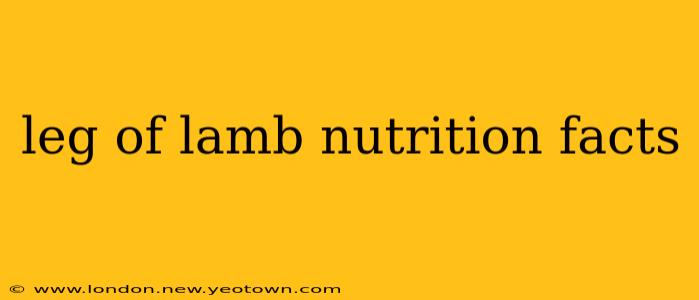The aroma of a perfectly roasted leg of lamb, its crispy exterior giving way to succulent, tender meat, is enough to make anyone's mouth water. But beyond its irresistible taste, leg of lamb offers a surprisingly impressive nutritional profile. This article delves into the nutritional facts of leg of lamb, exploring its benefits and answering common questions. We'll journey from the farm to the table, understanding what makes this cut of meat a valuable addition to a balanced diet.
What are the Nutritional Benefits of Leg of Lamb?
Leg of lamb is a lean protein source, relatively low in fat compared to other cuts, particularly when trimmed of excess fat before cooking. It's a powerhouse of essential nutrients, including:
- Protein: A crucial building block for muscles, tissues, and enzymes. Leg of lamb provides a significant amount of high-quality protein, essential for growth and repair.
- Iron: A vital mineral for carrying oxygen throughout the body. Leg of lamb contains a good amount of iron, particularly important for preventing anemia.
- B Vitamins: These vitamins play critical roles in energy metabolism, nerve function, and cell growth. Leg of lamb is a source of several B vitamins, including B12, which is primarily found in animal products.
- Zinc: Another important mineral involved in immune function, wound healing, and cell growth.
- Selenium: A powerful antioxidant that protects cells from damage.
The specific nutritional content varies depending on the cut, the animal's breed, diet, and the cooking method. However, generally, a 3-ounce serving of cooked leg of lamb provides around 20-25 grams of protein and a moderate amount of fat, with variations depending on the fat content.
How Many Calories are in a Leg of Lamb?
The calorie count in leg of lamb varies significantly depending on the size of the serving and the cooking method. A 3-ounce serving of cooked leg of lamb typically contains between 200-250 calories. Roasting, grilling, or broiling, all contribute to different levels of fat retention, so consider the preparation method. Trimming visible fat before cooking significantly reduces the overall calorie and fat content.
Is Leg of Lamb High in Cholesterol?
Yes, leg of lamb, like other red meats, does contain cholesterol. However, the cholesterol content is not necessarily a primary concern for healthy individuals, as dietary cholesterol's impact on blood cholesterol levels is less significant than previously thought. Focus on overall dietary cholesterol intake and heart-healthy fats.
How Much Fat is in a Leg of Lamb?
The fat content in leg of lamb can vary considerably based on factors mentioned earlier—the cut, fat trimming, and cooking method. A leaner cut, properly trimmed, and cooked without excessive added fats, will result in a lower overall fat content. Always opt for leaner cuts and trim away visible fat before cooking.
Is Leg of Lamb a Good Source of Iron?
Yes, leg of lamb is a good source of iron, specifically heme iron which is more readily absorbed by the body compared to non-heme iron found in plant-based foods. This makes it particularly beneficial for individuals who may be at risk of iron deficiency.
What are the Potential Downsides of Eating Leg of Lamb?
While leg of lamb offers numerous nutritional benefits, it's important to be mindful of a few potential downsides:
- Saturated Fat: Leg of lamb contains saturated fat, which, in excess, can contribute to high cholesterol levels. Moderation is key.
- Sodium: Some processed leg of lamb products might be high in sodium. Opt for fresh, minimally processed cuts and season your lamb yourself to control sodium intake.
- Potential for Contaminants: As with any meat, ensuring it's sourced from reputable suppliers and cooked to the correct internal temperature is crucial to minimize the risk of foodborne illnesses.
Conclusion: Enjoying Leg of Lamb in Moderation
Leg of lamb, when consumed as part of a balanced diet and in moderation, offers a delectable and nutritious meal. Its high protein, iron, and B vitamin content make it a valuable addition to a healthy eating plan. Remember to choose lean cuts, trim excess fat, and cook it properly to maximize its benefits while minimizing potential downsides. Enjoy this culinary delight responsibly!

